Asset Management in Real Estate: Analysis and Strategies Report
VerifiedAdded on 2023/06/03
|6
|1651
|178
Report
AI Summary
This report provides a comprehensive overview of real estate asset management. It begins by defining asset management and its functions within the real estate industry, emphasizing its role in maximizing property value and return on investment. The report explores the relationship between asset and property management, as well as the asset manager and owner/investor. It explains value creation, its interaction with the real estate cycle, and the demand drivers influencing property demand and location selection. The report categorizes real estate investors based on their investment motives and legal entities, detailing their influence on value and acquisition criteria. It differentiates between core and non-core real estate investments, outlining their characteristics, advantages, disadvantages, and roles within a portfolio. The report also discusses risk management strategies, including portfolio diversification, and concludes with a case study on the Village Market retail property, analyzing its central problems, the events leading to its non-performing status, and the impact of physical and external issues. The report also includes a detailed explanation of Management Plan and Budget along with the role of the Asset Manager.
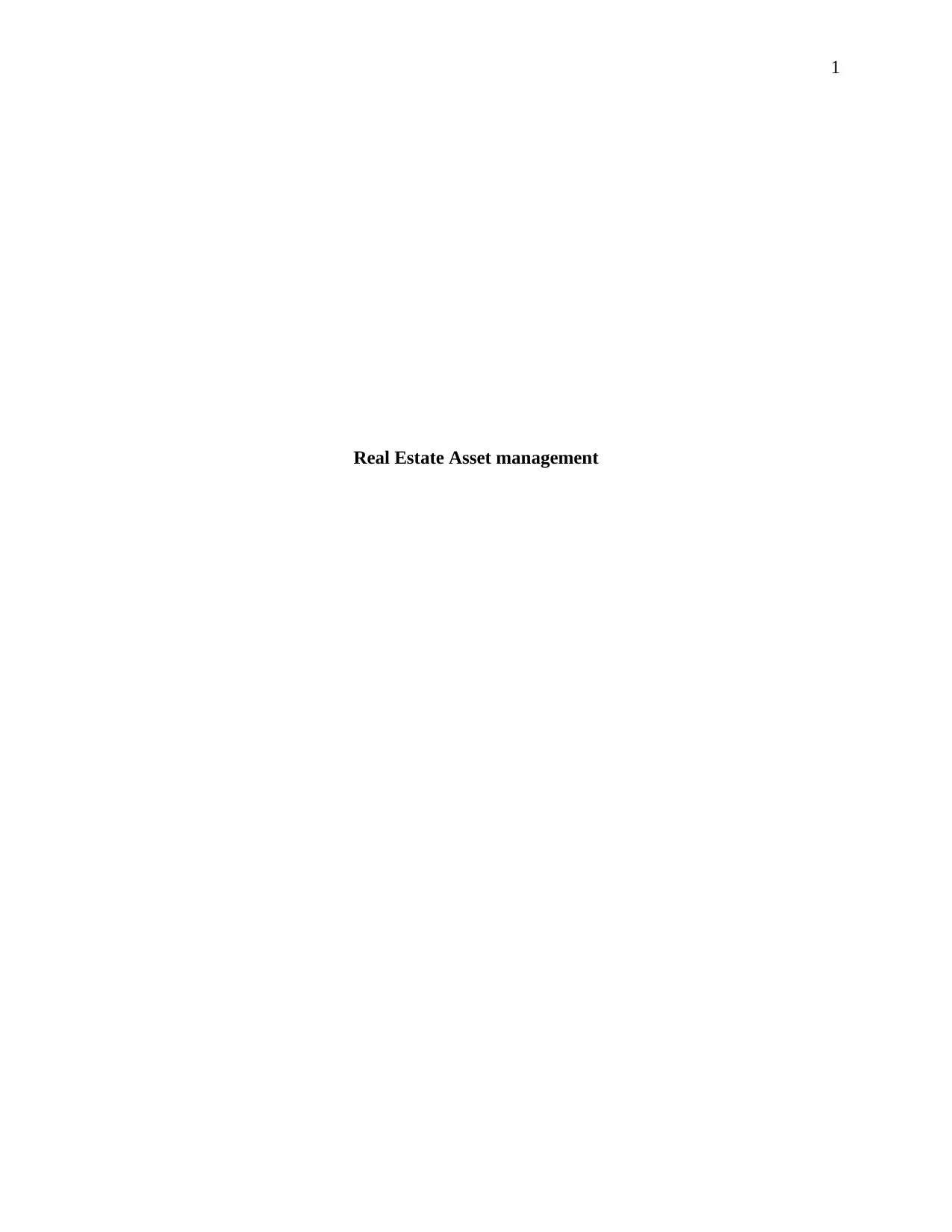
1
Real Estate Asset management
Real Estate Asset management
Paraphrase This Document
Need a fresh take? Get an instant paraphrase of this document with our AI Paraphraser
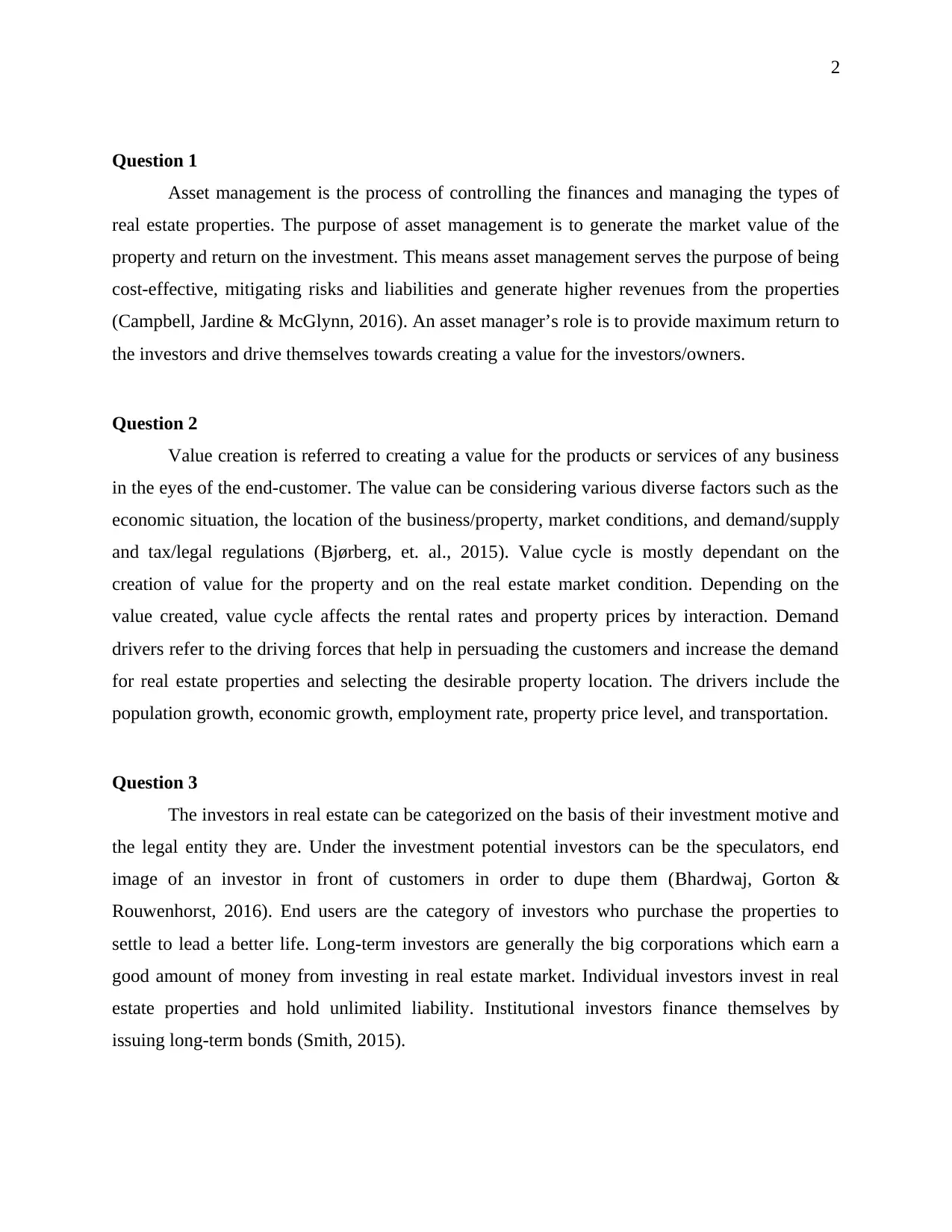
2
Question 1
Asset management is the process of controlling the finances and managing the types of
real estate properties. The purpose of asset management is to generate the market value of the
property and return on the investment. This means asset management serves the purpose of being
cost-effective, mitigating risks and liabilities and generate higher revenues from the properties
(Campbell, Jardine & McGlynn, 2016). An asset manager’s role is to provide maximum return to
the investors and drive themselves towards creating a value for the investors/owners.
Question 2
Value creation is referred to creating a value for the products or services of any business
in the eyes of the end-customer. The value can be considering various diverse factors such as the
economic situation, the location of the business/property, market conditions, and demand/supply
and tax/legal regulations (Bjørberg, et. al., 2015). Value cycle is mostly dependant on the
creation of value for the property and on the real estate market condition. Depending on the
value created, value cycle affects the rental rates and property prices by interaction. Demand
drivers refer to the driving forces that help in persuading the customers and increase the demand
for real estate properties and selecting the desirable property location. The drivers include the
population growth, economic growth, employment rate, property price level, and transportation.
Question 3
The investors in real estate can be categorized on the basis of their investment motive and
the legal entity they are. Under the investment potential investors can be the speculators, end
image of an investor in front of customers in order to dupe them (Bhardwaj, Gorton &
Rouwenhorst, 2016). End users are the category of investors who purchase the properties to
settle to lead a better life. Long-term investors are generally the big corporations which earn a
good amount of money from investing in real estate market. Individual investors invest in real
estate properties and hold unlimited liability. Institutional investors finance themselves by
issuing long-term bonds (Smith, 2015).
Question 1
Asset management is the process of controlling the finances and managing the types of
real estate properties. The purpose of asset management is to generate the market value of the
property and return on the investment. This means asset management serves the purpose of being
cost-effective, mitigating risks and liabilities and generate higher revenues from the properties
(Campbell, Jardine & McGlynn, 2016). An asset manager’s role is to provide maximum return to
the investors and drive themselves towards creating a value for the investors/owners.
Question 2
Value creation is referred to creating a value for the products or services of any business
in the eyes of the end-customer. The value can be considering various diverse factors such as the
economic situation, the location of the business/property, market conditions, and demand/supply
and tax/legal regulations (Bjørberg, et. al., 2015). Value cycle is mostly dependant on the
creation of value for the property and on the real estate market condition. Depending on the
value created, value cycle affects the rental rates and property prices by interaction. Demand
drivers refer to the driving forces that help in persuading the customers and increase the demand
for real estate properties and selecting the desirable property location. The drivers include the
population growth, economic growth, employment rate, property price level, and transportation.
Question 3
The investors in real estate can be categorized on the basis of their investment motive and
the legal entity they are. Under the investment potential investors can be the speculators, end
image of an investor in front of customers in order to dupe them (Bhardwaj, Gorton &
Rouwenhorst, 2016). End users are the category of investors who purchase the properties to
settle to lead a better life. Long-term investors are generally the big corporations which earn a
good amount of money from investing in real estate market. Individual investors invest in real
estate properties and hold unlimited liability. Institutional investors finance themselves by
issuing long-term bonds (Smith, 2015).
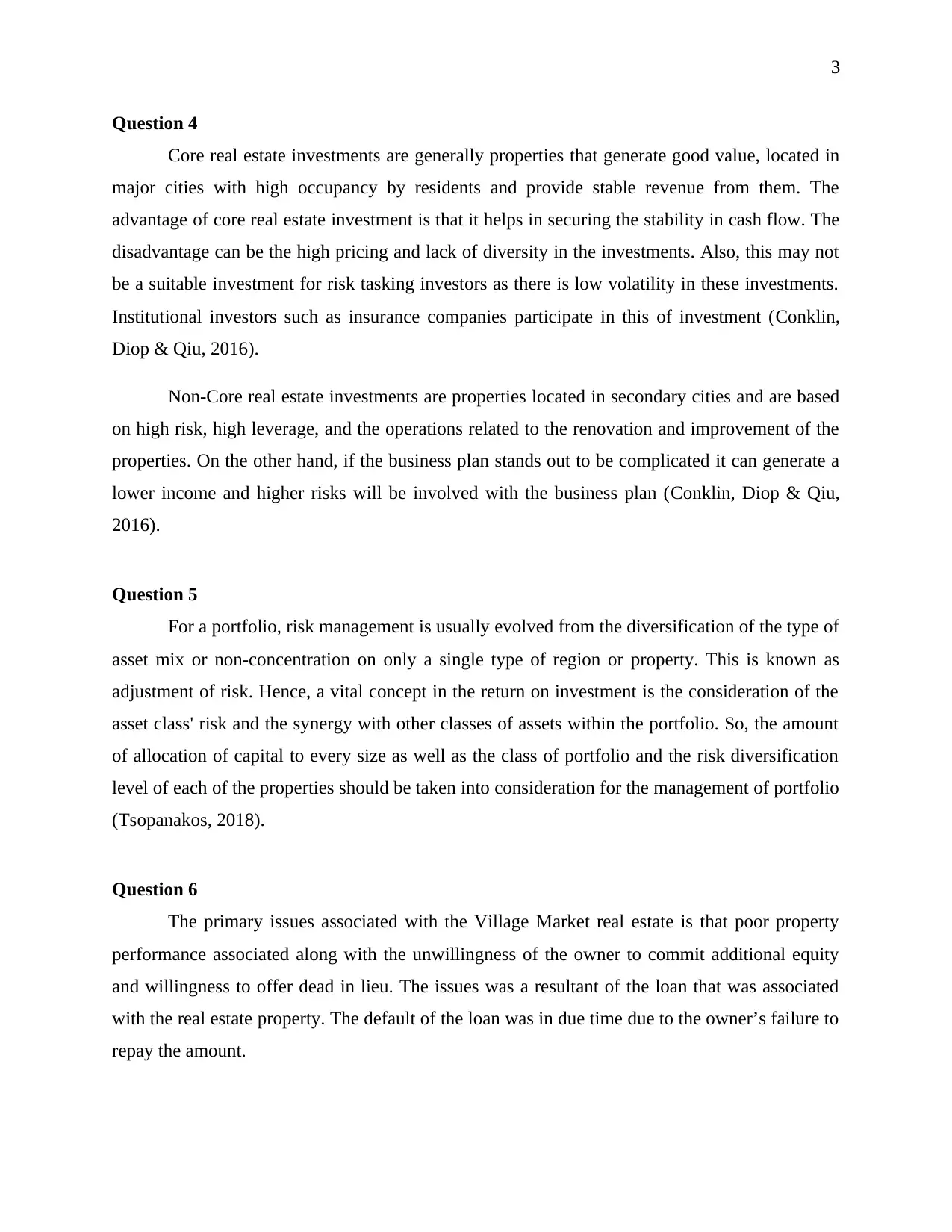
3
Question 4
Core real estate investments are generally properties that generate good value, located in
major cities with high occupancy by residents and provide stable revenue from them. The
advantage of core real estate investment is that it helps in securing the stability in cash flow. The
disadvantage can be the high pricing and lack of diversity in the investments. Also, this may not
be a suitable investment for risk tasking investors as there is low volatility in these investments.
Institutional investors such as insurance companies participate in this of investment (Conklin,
Diop & Qiu, 2016).
Non-Core real estate investments are properties located in secondary cities and are based
on high risk, high leverage, and the operations related to the renovation and improvement of the
properties. On the other hand, if the business plan stands out to be complicated it can generate a
lower income and higher risks will be involved with the business plan (Conklin, Diop & Qiu,
2016).
Question 5
For a portfolio, risk management is usually evolved from the diversification of the type of
asset mix or non-concentration on only a single type of region or property. This is known as
adjustment of risk. Hence, a vital concept in the return on investment is the consideration of the
asset class' risk and the synergy with other classes of assets within the portfolio. So, the amount
of allocation of capital to every size as well as the class of portfolio and the risk diversification
level of each of the properties should be taken into consideration for the management of portfolio
(Tsopanakos, 2018).
Question 6
The primary issues associated with the Village Market real estate is that poor property
performance associated along with the unwillingness of the owner to commit additional equity
and willingness to offer dead in lieu. The issues was a resultant of the loan that was associated
with the real estate property. The default of the loan was in due time due to the owner’s failure to
repay the amount.
Question 4
Core real estate investments are generally properties that generate good value, located in
major cities with high occupancy by residents and provide stable revenue from them. The
advantage of core real estate investment is that it helps in securing the stability in cash flow. The
disadvantage can be the high pricing and lack of diversity in the investments. Also, this may not
be a suitable investment for risk tasking investors as there is low volatility in these investments.
Institutional investors such as insurance companies participate in this of investment (Conklin,
Diop & Qiu, 2016).
Non-Core real estate investments are properties located in secondary cities and are based
on high risk, high leverage, and the operations related to the renovation and improvement of the
properties. On the other hand, if the business plan stands out to be complicated it can generate a
lower income and higher risks will be involved with the business plan (Conklin, Diop & Qiu,
2016).
Question 5
For a portfolio, risk management is usually evolved from the diversification of the type of
asset mix or non-concentration on only a single type of region or property. This is known as
adjustment of risk. Hence, a vital concept in the return on investment is the consideration of the
asset class' risk and the synergy with other classes of assets within the portfolio. So, the amount
of allocation of capital to every size as well as the class of portfolio and the risk diversification
level of each of the properties should be taken into consideration for the management of portfolio
(Tsopanakos, 2018).
Question 6
The primary issues associated with the Village Market real estate is that poor property
performance associated along with the unwillingness of the owner to commit additional equity
and willingness to offer dead in lieu. The issues was a resultant of the loan that was associated
with the real estate property. The default of the loan was in due time due to the owner’s failure to
repay the amount.
⊘ This is a preview!⊘
Do you want full access?
Subscribe today to unlock all pages.

Trusted by 1+ million students worldwide
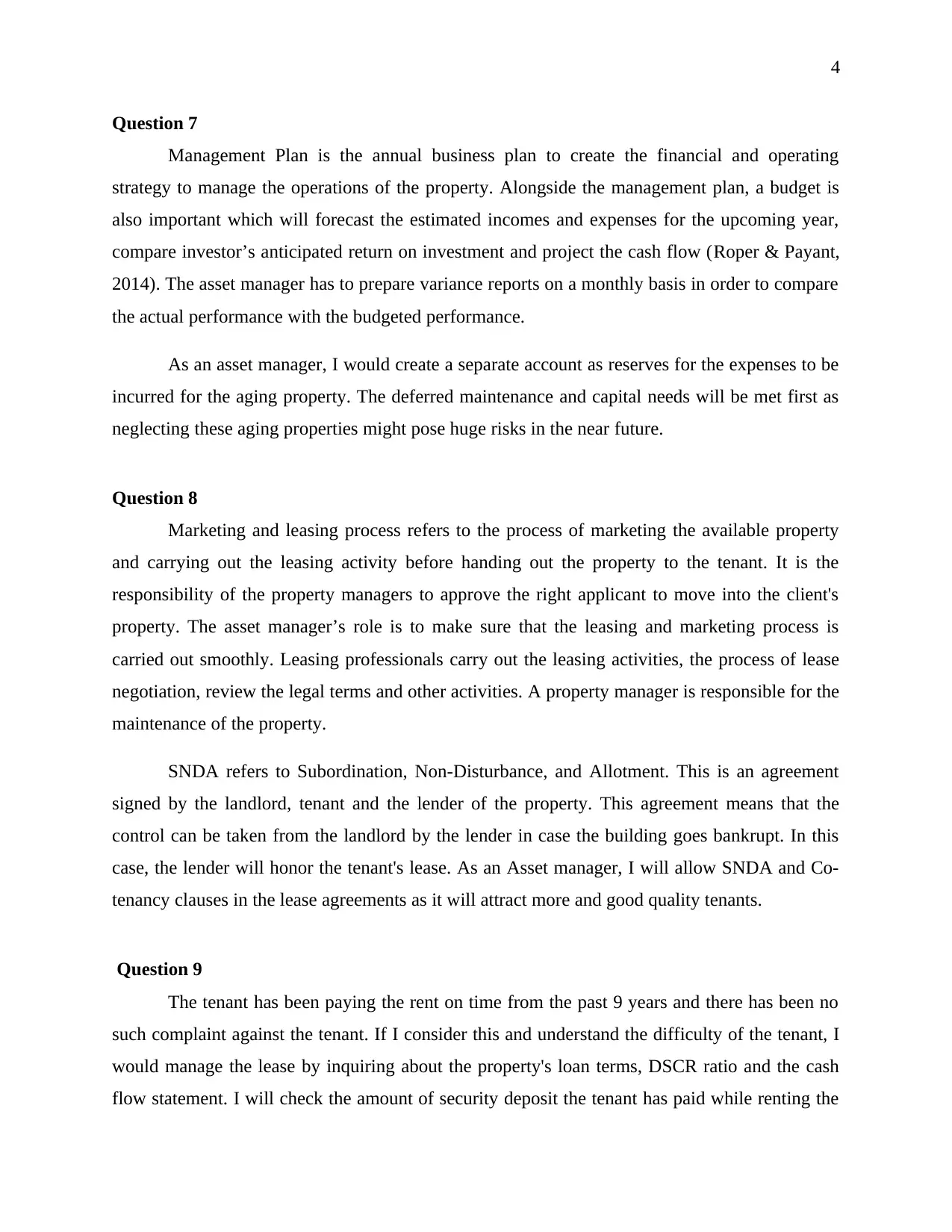
4
Question 7
Management Plan is the annual business plan to create the financial and operating
strategy to manage the operations of the property. Alongside the management plan, a budget is
also important which will forecast the estimated incomes and expenses for the upcoming year,
compare investor’s anticipated return on investment and project the cash flow (Roper & Payant,
2014). The asset manager has to prepare variance reports on a monthly basis in order to compare
the actual performance with the budgeted performance.
As an asset manager, I would create a separate account as reserves for the expenses to be
incurred for the aging property. The deferred maintenance and capital needs will be met first as
neglecting these aging properties might pose huge risks in the near future.
Question 8
Marketing and leasing process refers to the process of marketing the available property
and carrying out the leasing activity before handing out the property to the tenant. It is the
responsibility of the property managers to approve the right applicant to move into the client's
property. The asset manager’s role is to make sure that the leasing and marketing process is
carried out smoothly. Leasing professionals carry out the leasing activities, the process of lease
negotiation, review the legal terms and other activities. A property manager is responsible for the
maintenance of the property.
SNDA refers to Subordination, Non-Disturbance, and Allotment. This is an agreement
signed by the landlord, tenant and the lender of the property. This agreement means that the
control can be taken from the landlord by the lender in case the building goes bankrupt. In this
case, the lender will honor the tenant's lease. As an Asset manager, I will allow SNDA and Co-
tenancy clauses in the lease agreements as it will attract more and good quality tenants.
Question 9
The tenant has been paying the rent on time from the past 9 years and there has been no
such complaint against the tenant. If I consider this and understand the difficulty of the tenant, I
would manage the lease by inquiring about the property's loan terms, DSCR ratio and the cash
flow statement. I will check the amount of security deposit the tenant has paid while renting the
Question 7
Management Plan is the annual business plan to create the financial and operating
strategy to manage the operations of the property. Alongside the management plan, a budget is
also important which will forecast the estimated incomes and expenses for the upcoming year,
compare investor’s anticipated return on investment and project the cash flow (Roper & Payant,
2014). The asset manager has to prepare variance reports on a monthly basis in order to compare
the actual performance with the budgeted performance.
As an asset manager, I would create a separate account as reserves for the expenses to be
incurred for the aging property. The deferred maintenance and capital needs will be met first as
neglecting these aging properties might pose huge risks in the near future.
Question 8
Marketing and leasing process refers to the process of marketing the available property
and carrying out the leasing activity before handing out the property to the tenant. It is the
responsibility of the property managers to approve the right applicant to move into the client's
property. The asset manager’s role is to make sure that the leasing and marketing process is
carried out smoothly. Leasing professionals carry out the leasing activities, the process of lease
negotiation, review the legal terms and other activities. A property manager is responsible for the
maintenance of the property.
SNDA refers to Subordination, Non-Disturbance, and Allotment. This is an agreement
signed by the landlord, tenant and the lender of the property. This agreement means that the
control can be taken from the landlord by the lender in case the building goes bankrupt. In this
case, the lender will honor the tenant's lease. As an Asset manager, I will allow SNDA and Co-
tenancy clauses in the lease agreements as it will attract more and good quality tenants.
Question 9
The tenant has been paying the rent on time from the past 9 years and there has been no
such complaint against the tenant. If I consider this and understand the difficulty of the tenant, I
would manage the lease by inquiring about the property's loan terms, DSCR ratio and the cash
flow statement. I will check the amount of security deposit the tenant has paid while renting the
Paraphrase This Document
Need a fresh take? Get an instant paraphrase of this document with our AI Paraphraser
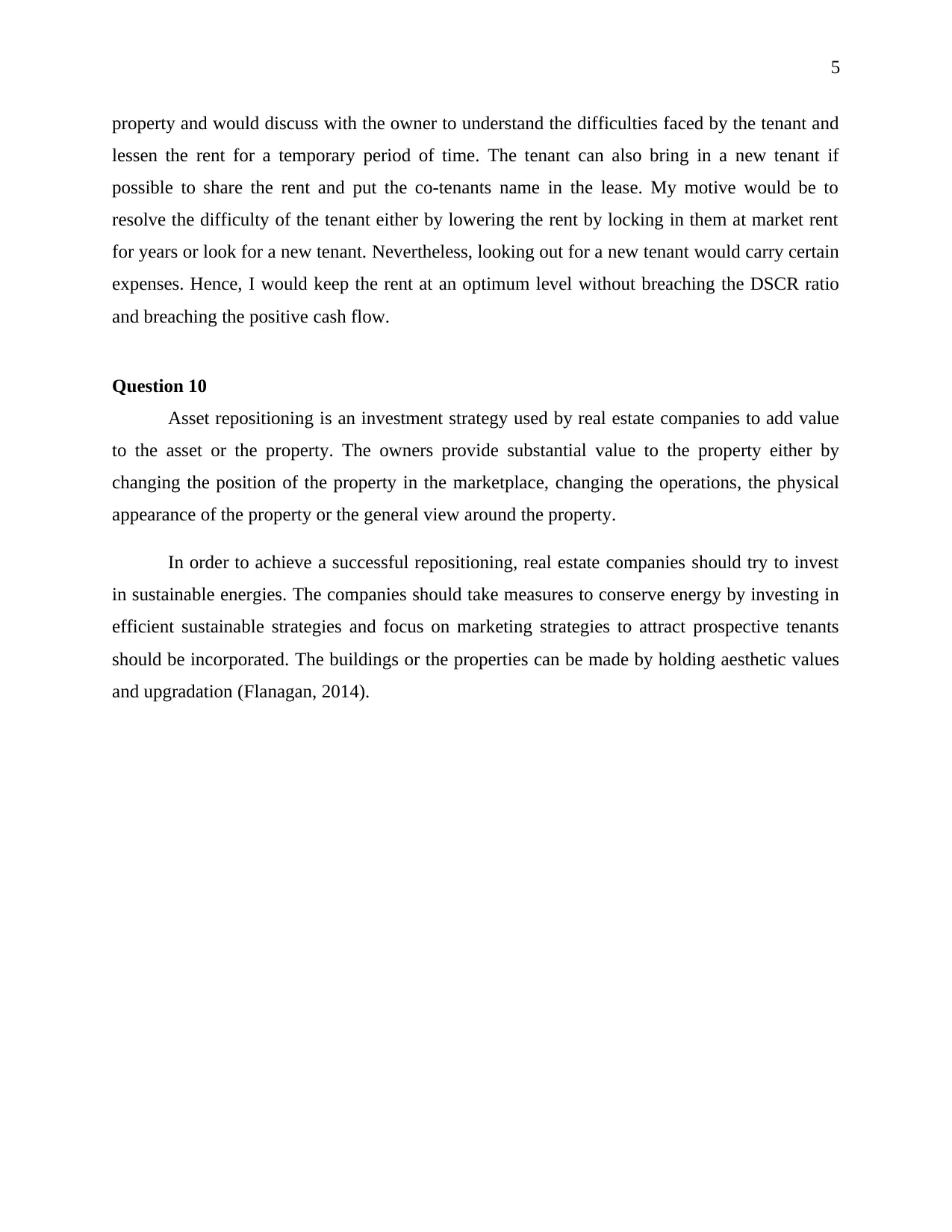
5
property and would discuss with the owner to understand the difficulties faced by the tenant and
lessen the rent for a temporary period of time. The tenant can also bring in a new tenant if
possible to share the rent and put the co-tenants name in the lease. My motive would be to
resolve the difficulty of the tenant either by lowering the rent by locking in them at market rent
for years or look for a new tenant. Nevertheless, looking out for a new tenant would carry certain
expenses. Hence, I would keep the rent at an optimum level without breaching the DSCR ratio
and breaching the positive cash flow.
Question 10
Asset repositioning is an investment strategy used by real estate companies to add value
to the asset or the property. The owners provide substantial value to the property either by
changing the position of the property in the marketplace, changing the operations, the physical
appearance of the property or the general view around the property.
In order to achieve a successful repositioning, real estate companies should try to invest
in sustainable energies. The companies should take measures to conserve energy by investing in
efficient sustainable strategies and focus on marketing strategies to attract prospective tenants
should be incorporated. The buildings or the properties can be made by holding aesthetic values
and upgradation (Flanagan, 2014).
property and would discuss with the owner to understand the difficulties faced by the tenant and
lessen the rent for a temporary period of time. The tenant can also bring in a new tenant if
possible to share the rent and put the co-tenants name in the lease. My motive would be to
resolve the difficulty of the tenant either by lowering the rent by locking in them at market rent
for years or look for a new tenant. Nevertheless, looking out for a new tenant would carry certain
expenses. Hence, I would keep the rent at an optimum level without breaching the DSCR ratio
and breaching the positive cash flow.
Question 10
Asset repositioning is an investment strategy used by real estate companies to add value
to the asset or the property. The owners provide substantial value to the property either by
changing the position of the property in the marketplace, changing the operations, the physical
appearance of the property or the general view around the property.
In order to achieve a successful repositioning, real estate companies should try to invest
in sustainable energies. The companies should take measures to conserve energy by investing in
efficient sustainable strategies and focus on marketing strategies to attract prospective tenants
should be incorporated. The buildings or the properties can be made by holding aesthetic values
and upgradation (Flanagan, 2014).
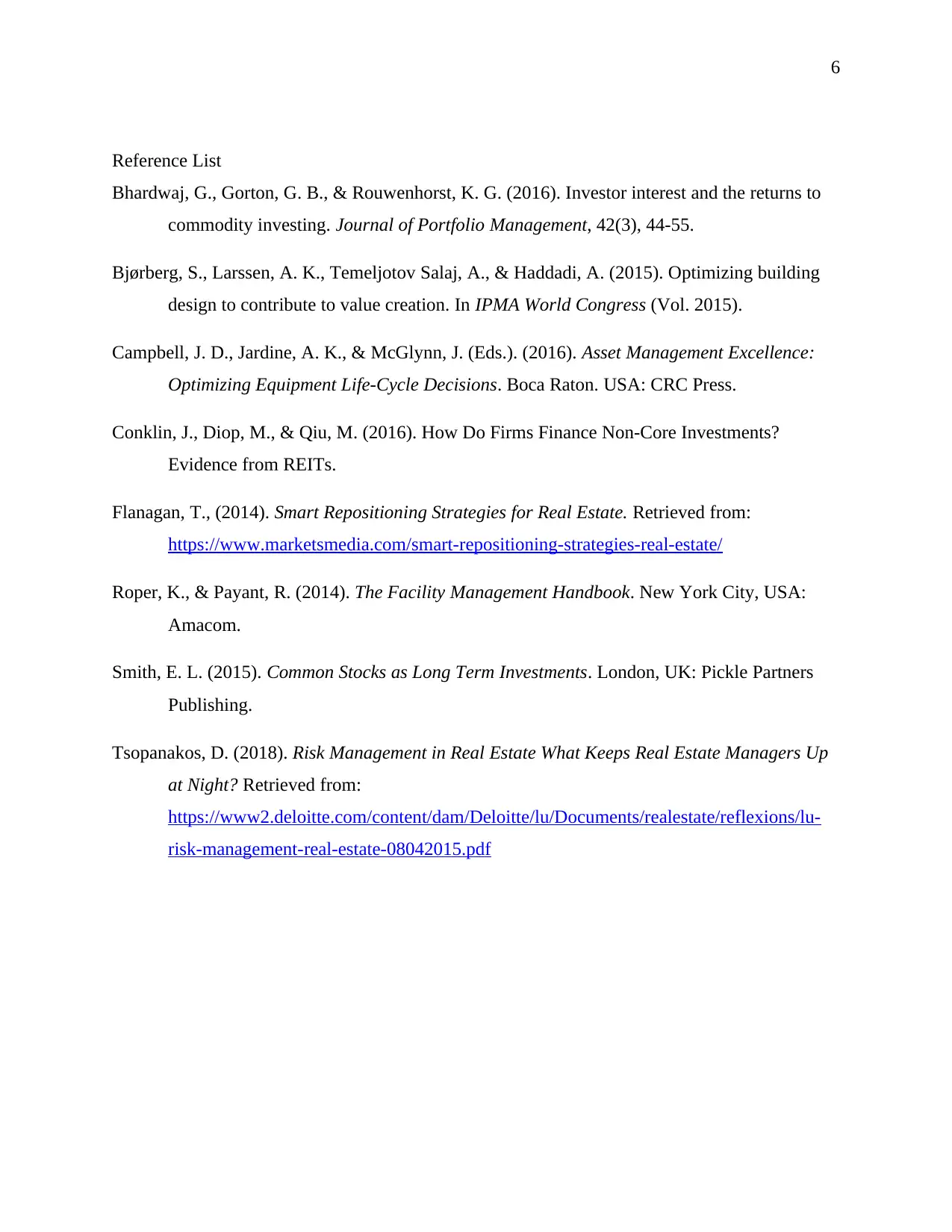
6
Reference List
Bhardwaj, G., Gorton, G. B., & Rouwenhorst, K. G. (2016). Investor interest and the returns to
commodity investing. Journal of Portfolio Management, 42(3), 44-55.
Bjørberg, S., Larssen, A. K., Temeljotov Salaj, A., & Haddadi, A. (2015). Optimizing building
design to contribute to value creation. In IPMA World Congress (Vol. 2015).
Campbell, J. D., Jardine, A. K., & McGlynn, J. (Eds.). (2016). Asset Management Excellence:
Optimizing Equipment Life-Cycle Decisions. Boca Raton. USA: CRC Press.
Conklin, J., Diop, M., & Qiu, M. (2016). How Do Firms Finance Non-Core Investments?
Evidence from REITs.
Flanagan, T., (2014). Smart Repositioning Strategies for Real Estate. Retrieved from:
https://www.marketsmedia.com/smart-repositioning-strategies-real-estate/
Roper, K., & Payant, R. (2014). The Facility Management Handbook. New York City, USA:
Amacom.
Smith, E. L. (2015). Common Stocks as Long Term Investments. London, UK: Pickle Partners
Publishing.
Tsopanakos, D. (2018). Risk Management in Real Estate What Keeps Real Estate Managers Up
at Night? Retrieved from:
https://www2.deloitte.com/content/dam/Deloitte/lu/Documents/realestate/reflexions/lu-
risk-management-real-estate-08042015.pdf
Reference List
Bhardwaj, G., Gorton, G. B., & Rouwenhorst, K. G. (2016). Investor interest and the returns to
commodity investing. Journal of Portfolio Management, 42(3), 44-55.
Bjørberg, S., Larssen, A. K., Temeljotov Salaj, A., & Haddadi, A. (2015). Optimizing building
design to contribute to value creation. In IPMA World Congress (Vol. 2015).
Campbell, J. D., Jardine, A. K., & McGlynn, J. (Eds.). (2016). Asset Management Excellence:
Optimizing Equipment Life-Cycle Decisions. Boca Raton. USA: CRC Press.
Conklin, J., Diop, M., & Qiu, M. (2016). How Do Firms Finance Non-Core Investments?
Evidence from REITs.
Flanagan, T., (2014). Smart Repositioning Strategies for Real Estate. Retrieved from:
https://www.marketsmedia.com/smart-repositioning-strategies-real-estate/
Roper, K., & Payant, R. (2014). The Facility Management Handbook. New York City, USA:
Amacom.
Smith, E. L. (2015). Common Stocks as Long Term Investments. London, UK: Pickle Partners
Publishing.
Tsopanakos, D. (2018). Risk Management in Real Estate What Keeps Real Estate Managers Up
at Night? Retrieved from:
https://www2.deloitte.com/content/dam/Deloitte/lu/Documents/realestate/reflexions/lu-
risk-management-real-estate-08042015.pdf
⊘ This is a preview!⊘
Do you want full access?
Subscribe today to unlock all pages.

Trusted by 1+ million students worldwide
1 out of 6
Related Documents
Your All-in-One AI-Powered Toolkit for Academic Success.
+13062052269
info@desklib.com
Available 24*7 on WhatsApp / Email
![[object Object]](/_next/static/media/star-bottom.7253800d.svg)
Unlock your academic potential
Copyright © 2020–2025 A2Z Services. All Rights Reserved. Developed and managed by ZUCOL.





